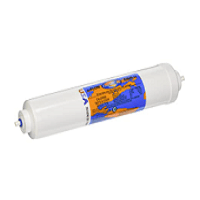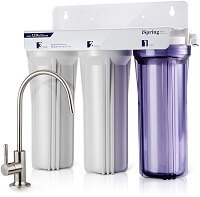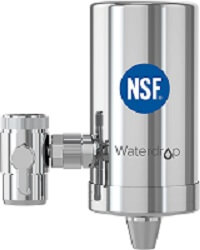Water filtration has come a long way since the early days of emerging water purification techniques. Many factors go into the overall design and manufacturing evaluation as to whether any given material is an effective mode of filtration. As one of the more effective routes, solid carbon blocks have dominated the industry of water treatment, especially in the POU (or Point of Use) category. This specific method of water filtration employees other filter tech, in addition to standalone treatment methods. Here we will address a few key buyer considerations in regard to sifting through suppliers, as well as overall filter specifications.
Filtering Water with Activated Carbon
There are two forms of activated carbon for water filtration, including: carbon block, and Granular Activated Carbon (or GAC). The difference between the two being particle size, with GAC granules ranging from 0.30-0.84 mm. Carbon block, on the other hand, provide a small mesh measuring anywhere between 0.045-0.18mm – or 7-19x smaller than GAC. As such, activated carbon has earned it's place filtering away contaminants, odors, and tastes from certain water sources. With large surface areas on filter material being the prime factor in contaminant absorption, it should come as no surprise to learn that activated carbon has an increased porosity on a granule level. With such a low cost, and wide availability, activated carbon makes an excellent options for a wide range of residential and commercial uses.
Why is Carbon Block the Best Choice?
Binding agents and activated carbon granules work together to provide the magic behind carbon block filtration. The binding agent works with the granules to maintain a static position that remains relative to one another. With filtration utilizing carbon block, granules of activated carbon are immobilized to prevent water from channeling, and promote a uniform performance. This is compared to GAC, which typically sits loosely contained in the bed of a pressure vessel, or enclosed cartridge. In the case of GAC, the product takes advantage of the path of least resistance, which proves useful in terms of water filtration. A carbon block, on the other hand, is formed to predetermined dimensions for cartridge use, with end caps forcing the flow of water through static pores.
Higher effectiveness, in terms of reducing overall contaminants, is achieved by carbon block via uniform pore structure held between individual carbon granules. A carbon block's pure ability to remove various contaminants is further increased as uniform pore structure plays a vital role in increasing contact time between filter media and tap water. This is due, in part, to the smaller particle size of carbon block, in addition to uniform pore structure. Compared to GAC, carbon block has a high level of effectiveness in a smaller package, at a similar flow rate. For this reason, GAC has been utilized as an effective treatment in terms of aesthetics contaminants, including: color, odor, and flavor. GAC, however, cannot stand up next to the additional effectiveness at removing volatile organic chemicals (or VOCs), cysts, lead, etc., presented by carbon block filters.
Carbon block is better enabled to reduce or remove various impurities in a shorter span of contact time, due to a higher density of carbon particles, as well as higher overall operating efficiency. Consumers also note minimal carbon fines, or carbon dust, produced by carbon block filtration, whereas GAC filters release a surge of black water upon initial use. The inherent static composition of carbon block minimizes the need for flushing or backwashing, virtually eliminating carbon fines during normal operation. Point of Use filtration products greatly benefit from applications utilizing either carbon block or GAC, with carbon block closing in the gap. As such, a more diverse product lineup is being created due to a demand for the small form factor set forth by the nature of carbon block.
The loose cartridge bed of a GAC filter presents ample room for the colonization of bacteria, a common problem among cheap filtration. Carbon block's advantages over GAC are further highlighted by a filter's inability to grow bacteria internally, due to carbon block's pore size. In all, carbon block is the superior choice in affordable filtration, simply because of it's effectiveness against contaminants, compact size, resistance to bacterial growth, low cost, and small form factor, not to mention its use of renewable resources.

Carbon Filter Design Specs
Utilizing Raw Materials
When looking into the raw materials utilized by carbon filter manufacturers, consumers would be pleasantly surprised to discover a wide variety of components. Nutshells, bituminous coal, and wood are just a few of the most common sources of carbon, with bituminous based coal being the most inexpensive and plentiful option. Coal-based carbons, however, run the risk of being contaminated with alarming levels of pollutants proven to leach into drinking water. Wood-based carbons, on the other hand, are well equipped to reduce the overall presence of specific contaminants, which is also renewable, and readily available. The overall timeframe for tree maturation can become a problem, though, as trees can take many years to mature. This presents nutshells, especially coconut shells, as the most ideal source of carbon for use in water filtration.
Why is coconut shell carbon the heavy hitter when it comes to filtering water? A higher porosity and greater surface area is provided by an innately higher volume of micropores found in coconut shell, especially when compared to other forms of carbon. In fact, consumers are given up to 50% more micropores through the use of activated coconut shell carbon, than bituminous coal based activated carbon. High porosity and greater surface area enables coconut shell carbon to maintain a greater absorptive capacity, capable of absorbing small organic molecules (think VOCs here).
Objectives of Higher Filter Performance
When it comes to evaluating the overall performance of a carbon block filter, there are numerous considerations. The filter's target capacity is one of the top basic performance characteristics evaluated, which is defined as the gallons of water filtered before replacement is needed. Flow rate is another aspect, determined by the continuous flow of gallons of water over a predetermined amount of time, typically gallons per minute. Additionally, the operating pressure required for the unit to perform appropriately as a filter, is measured in pounds per square inch, or psi. A micron rating, for example, represents a particles minimum size for optimal mechanical filtration, in order to provide the best indicator of overall pore size. This better informs consumers of the contaminant filtration capabilities set forth by various manufacturers and models.
Validating Overall Performance
Independent lab testing has been proven to be an invaluable tool in the overall evaluation of carbon block filter performance. Products are tested against the NSF International, and American National Standards Institute standards, in order to provide contaminant removal or reduction ratings based on the Maximum Contaminant Level of the US Environmental Protection Agency. These drinking water filter standards have steadily evolved beyond the simple measurement of contaminants, before and after filtration. These standards also dictate water characteristics, including temperature, pH, and levels of minerals such as magnesium, or calcium. Aside from structuring testing for measuring contaminants, etc., there are constraints surrounding the procedures of sampling and testing water, too. Such standards ensure adequate steps are taken to assure overall filter performance, especially when tested under the most realistic water conditions possible.
Guide to Carbon Water Filters & Reviews
Omnipure Inline Carbon Water Filter
This filter provides a respectable lifespan of 1,000 gallons, or one year of regular operation. For this reason alone, the Omnipure Inline filter provides the best bang for your buck, at a price you can afford. For the money, with low prices and annual filter replacements, you can't go wrong with an inline carbon water filter from Omnipure. The utilization of 3/8” quick fittings make this inline filter a quick install, with easy replacements on an as needed basis. However, due to a low flow rate (less than 0.6 gallons per minute), may grown into an irritating problem, especially when the demand for cold water is high.
iSpring 3-Stage Carbon Under-Sink Water Filters
There's nothing like the crisp and clean water produced by an iSpring filter – it's very characteristic. This is due to the three stages of filtration the US31 utilizes for the efficient removal and control of bacteria, parasites, arsenic, heavy metals, and lead. Overall, users can expect anywhere between 6 to 12 months of regular use before a replacement is required, depending on demand and water source conditions. However, for the money required, consumers would be paying a premium for the convenience of a second faucet in order to receive iSpring's benefits on demand.
Waterdrop WD-FC-06 Carbon Block Faucet Water Filtration System
When consumers need the convenience and function of the aforementioned brands in one neat package, the Waterdrop Water Faucet Filtration System is a notch above the rest. By simply screwing the unit onto the end of your faucet, carbon block made of coconut shell, goes to work improving odor and taste through the removal of chlorine, and various suspended solids. Remineralization media also imparts beneficial minerals crucial to longevity and good health. A lifespan of 320 gallons means the average user can expect up to 3 months of regular use, in a sleek package anyone will appreciate. Additionally, once the system is installed, users can simply swap from tap to filtered water all with the flip of a switch.






